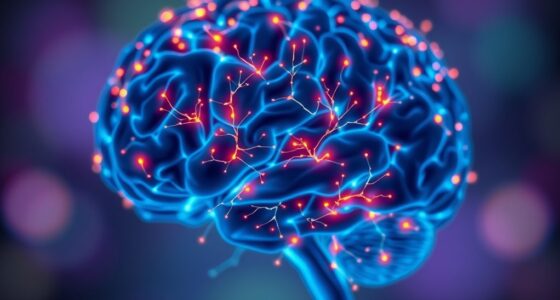When you give, your brain activates reward pathways that release dopamine, making you feel pleasure and satisfaction. Additionally, giving boosts oxytocin levels, strengthening social bonds and trust. This neural response reinforces future acts of generosity, creating a cycle of positive feelings and deeper connections. Giving not only benefits others but also enhances your emotional well-being and relationships. Keep exploring, and you’ll uncover how these brain mechanisms work together to make giving truly rewarding.
Key Takeaways
- Giving activates brain reward pathways, releasing dopamine that creates feelings of pleasure and motivation.
- The release of oxytocin during giving enhances trust, emotional bonds, and social connection.
- Neural feedback from gratitude and positive responses reinforce generous behaviors over time.
- Giving involves intentional effort, which amplifies happiness and the sense of purpose compared to simply receiving.
- These neural mechanisms promote emotional well-being, strengthen relationships, and support social cohesion.

When you give a gift, your brain activates specific neural pathways that reinforce feelings of connection and reward. This process is rooted in the release of dopamine, the neurotransmitter associated with pleasure and motivation. As you select and present a gift, dopamine floods your brain, creating a sense of satisfaction and happiness. That rush of positive feelings encourages you to repeat the giving behavior, strengthening bonds with others. It’s a biological reward system that makes giving not just meaningful but also inherently pleasurable.
But it’s not just dopamine at play. Giving also triggers the release of oxytocin, often called the “bonding hormone.” When your gift is received and appreciated, oxytocin levels rise, fostering feelings of trust and emotional closeness. This hormone promotes social bonding, making both you and the recipient feel more connected. The act of giving becomes a shared experience that deepens your relationship, whether it’s with a friend, family member, or even a stranger. Oxytocin’s role in bonding explains why giving can generate such a strong sense of warmth and attachment.
Your brain’s response to gift-giving reveals why it feels so good to give. When you see the recipient’s smile or express gratitude, it reinforces the positive neural pathways created by dopamine and oxytocin. This feedback loop fuels your desire to give again, as your brain associates generosity with reward and connection. It’s a cycle that benefits both giver and receiver, fostering social cohesion and emotional well-being.
Seeing gratitude and smiles reinforces neural rewards, fueling generosity and strengthening social bonds.
Moreover, the act of giving activates the brain’s reward circuitry in a way that’s distinct from receiving. While receiving gifts can also trigger dopamine release, giving often leads to a more sustained sense of happiness because it involves intentionality and effort. Your brain recognizes that you’re contributing to someone else’s happiness, which enhances the feelings of purpose and fulfillment. This altruistic aspect amplifies the neural reward, making giving a powerful emotional experience.
In essence, understanding the neuroscience behind gift-giving clarifies why it feels so rewarding. Your brain is wired to seek connection and pleasure through generosity. Dopamine and oxytocin work together to make giving an enriching act that benefits both your emotional health and your relationships. That’s why giving doesn’t just help others—it also makes you feel genuinely good inside. Additionally, engaging in giving can activate homeostasis mechanisms, which help regulate your overall mental and emotional balance, further reinforcing the positive effects of altruism.
Frequently Asked Questions
How Does Gift-Giving Influence Long-Term Brain Health?
Gift-giving boosts your long-term brain health by enhancing neural plasticity and emotional regulation. When you give, your brain forms new connections, strengthening neural pathways that support adaptability and learning. It also helps you manage emotions better, reducing stress and increasing feelings of happiness. Over time, these positive effects promote mental resilience and cognitive health, making you more emotionally balanced and adaptable as you age.
Are There Cultural Differences in the Neuroscience of Giving?
You’ll find that cultural differences shape the neuroscience of giving through varying cross-cultural norms. These norms influence neural responses, making giving feel more rewarding in some cultures than others. For example, in collectivist societies, you might experience heightened activity in brain regions associated with social harmony and empathy, whereas individualistic cultures may emphasize reward-related neural pathways. Understanding these neural differences helps you appreciate how culture impacts the emotional and neurological aspects of gift-giving.
What Role Do Hormones Like Oxytocin Play in Gift Satisfaction?
Did you know that giving a gift can boost your happiness by triggering oxytocin bonding and dopamine reward? When you give, oxytocin floods your brain, strengthening emotional bonds, while dopamine creates a sense of pleasure. This hormonal interplay makes gift-giving incredibly satisfying, reinforcing your desire to connect with others. So, your brain’s chemistry actively rewards generosity, making every gift you give feel even more meaningful and joyful.
Can Giving Gifts Boost Mental Health in Clinical Populations?
Yes, giving gifts can boost mental health in clinical populations by improving emotional regulation and strengthening social bonding. When you give, your brain releases feel-good hormones like oxytocin, which enhance mood and reduce stress. This act fosters deeper connections with others, helping you feel more supported and less isolated. Engaging in gift-giving can therefore be a powerful tool to promote emotional well-being and build resilience in those facing mental health challenges.
How Does Age Affect the Neural Response to Giving and Receiving?
Imagine your brain as a vibrant garden, where age-related neural plasticity shapes how you respond to giving and receiving. As you age, developmental reward pathways become more refined, leading to deeper feelings of satisfaction when giving. Younger brains might respond with heightened activity in reward centers, while older brains find joy in meaningful connections. Your neural responses evolve, making gift-giving increasingly rewarding across your lifespan.
Conclusion
Remember, it’s true that giving feels good because your brain releases feel-good chemicals like dopamine and oxytocin. When you give, you activate neural pathways that boost your happiness and strengthen connections with others. So, next time you’re choosing a gift, keep in mind the saying, “It’s better to give than to receive.” Your act of kindness not only brightens someone else’s day but also fills your own heart with joy.










